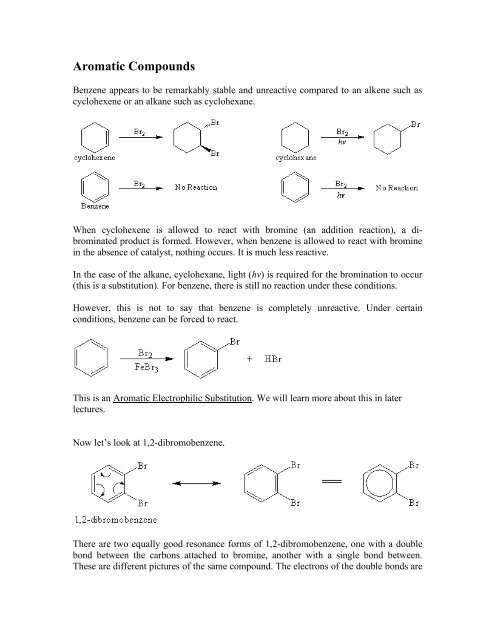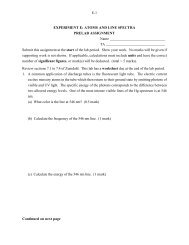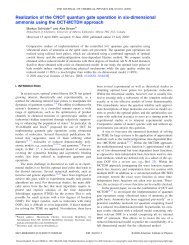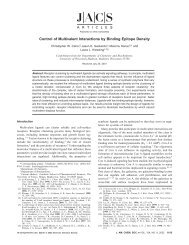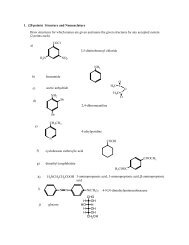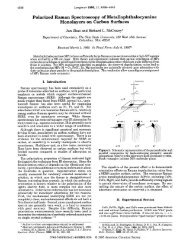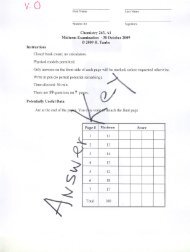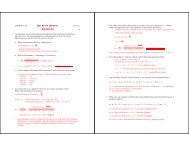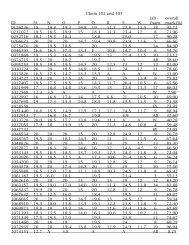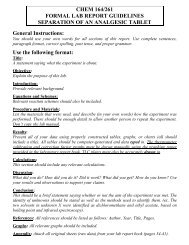Aromatic Compounds
Aromatic Compounds
Aromatic Compounds
You also want an ePaper? Increase the reach of your titles
YUMPU automatically turns print PDFs into web optimized ePapers that Google loves.
<strong>Aromatic</strong> <strong>Compounds</strong>Benzene appears to be remarkably stable and unreactive compared to an alkene such ascyclohexene or an alkane such as cyclohexane.When cyclohexene is allowed to react with bromine (an addition reaction), a dibrominatedproduct is formed. However, when benzene is allowed to react with brominein the absence of catalyst, nothing occurs. It is much less reactive.In the case of the alkane, cyclohexane, light (hv) is required for the bromination to occur(this is a substitution). For benzene, there is still no reaction under these conditions.However, this is not to say that benzene is completely unreactive. Under certainconditions, benzene can be forced to react.This is an <strong>Aromatic</strong> Electrophilic Substitution. We will learn more about this in laterlectures.Now let’s look at 1,2-dibromobenzene.There are two equally good resonance forms of 1,2-dibromobenzene, one with a doublebond between the carbons attached to bromine, another with a single bond between.These are different pictures of the same compound. The electrons of the double bonds are
Is this molecule aromatic?Answer: No. It has 8 π electrons, but it does not fit with 4n+2 rule. No integer value of nwill give 8. Therefore, it will behave like an alkene.In addition, the molecule does not adopt planar conformation. It is actually tub-shaped. Inplanar cyclooctatetraene, there is some angle and torsional strain. The angle in regularflat octagon is 135°, far from the optimum sp 2 value of 120°, hence the tub shape. Whenthe molecule is not planar, the p orbitals cannot effectively overlap with each other, the πelectrons are not delocalized and the molecule becomes unconjugated. Hence, it is notaromatic.cis-trans isomerization does not occur in this molecule, and the trans isomer shown abovedoes not exist because there is too much strain (can’t have trans double bond in smallrings).CyclodecapentaeneThis molecule has 10 π electrons. It fits with 4n+2 rule (n = 2). Although it seems to bearomatic, the hydrogens shown in the figure interfere with one another, and the moleculecannot adopt planar conformation. Therefore, it is not aromatic.Let’s take look at some anions and cations, and ask yourself are they aromatic and if theyare stable.Cyclopropane and cyclopropene are extremely reactive compounds due to angle strain.The normal preferred angle of an alkane is 109° and for a double bond is 120°. In both ofthese molecules, the internal angle is 60°. They are highly strained.When cyclopropene undergoes oxidation, it forms cyclopropenium cation.
Is this cation aromatic?Answer: Yes. This molecule fits the criteria for aromaticity. It is cyclic, planar andconjugated. It has 4n+2 π electrons (n = 0).Now that we saw cyclopropenium cation is aromatic, we can ask ourselves if the radicalis aromatic.Answer: No. It does not fit with 4n+2 rule. There are 3 π electrons.What about the anion?Answer: No. It has 4 π electrons, and it is anti-aromatic like cyclobutadiene.In cyclopropene system, the cation is easily formed since it is more stable (aromatic),where as radicals and anions are hard to make.Let’s look at another system.Is cyclopentadienyl anion <strong>Aromatic</strong>?Answer: Yes. It is cyclic. It is planar. It is conjugated (the anion has alternating singleand double bonds). It has 6 π electrons (therefore fits the 4n+2 rule).The pKa of the hydrogen shown on the parent cyclopentadiene on the above figure isaround 16. A normal alkane hydrogen pKa is around 45. The acidity of thecyclopentadiene hydrogen has been enhanced by 30 orders of magnitude (30 pKa units)
due to the extra stability of the cyclopentadienyl anion (recall that the acidity of amolecule depend on the stability of its conjugate anion).HeterocyclesHeterocycles have rings with atoms other than carbon. Keep in mind that this is a broadterm, includes lots of molecules that may or may not be aromatic.Example:Cornine is a heterocycle produced by the poison hemlock. It is a neurotoxin (which wasonce used to end Socrates’ life).Is this compound chiral?Answer: Yes. It has a stereogenic center (marked by the asterisk). An interesting thing tonote is that if the stereochemistry of the chiral center is changed, the compound is nottoxic anymore.Is this compound aromatic?Answer: No. It is not conjugated since there is no double bond present in the molecule.Example:Furan is a heterocyclic compound. It is planar and has conjugated double bonds.Now ask yourself if this compound is aromatic. The answer is yes. Furan is an aromaticcompound.How? One of the lone pairs of electrons on the oxygen is conjugated into the ring system.The p orbitals of the double bonds are in parallel with one another. The oxygen arrangesitself geometrically such that one of the lone pairs on the oxygen is also in parallel withthe p orbital of the double bonds, and the electrons are conjugated. The other lone pairwill stick out of the ring like the hydrogens on the double bonds. Within the ring, therewould be total of 6 π electrons.
(Molecules organize themselves and become aromatic if they can since aromaticitygives extra resonance stabilization).Example:Pyridine is a heterocyclic compound. It is planar, conjugated and has 6 π electrons.In the case of pyridine, the lone pair on the nitrogen does not participate in electrondelocalization within the ring since there are already 6 π electrons. Instead, the lone pairis perpendicular (90 degrees) to the p orbitals (π system) and in the plane of the ring andits hydrogens.Example:Is the molecule aromatic?Answer: Yes. Similar to furan, the lone pair on the nitrogen participates in conjugationwith the double bonds. There are total of 6 π electrons.Example:This compound is aromatic. Like pyrrole, the lone pair on the nitrogen bearing ahydrogen participates in making the aromatic system. The other nitrogen without thehydrogen has its lone pair at right angles to the π system (as in pyridine).
Example:Is this cation aromatic?Answer: Yes, it is. The cation is cyclic, planar, fully conjugated with the double bonds,and has 6 π electrons. The electrons are delocalized in the ring, and each carbon shares1/7 positive charge.Benzene DerivativesNomenclature of substituted benzene ringsReview the substituted benzene structures from the last lecture, including toluene, phenol,aniline, benzoic acid and benzaldehyde (will be tested on exams).When you have two substituents on a benzene ring, ortho, meta, and para are used to tellwhere the second substitution is relative to the first one.Ortho refers to 1,2-substitutionMeta refers to 1,3-substitutionPara refers to 1,4-substitution
Example:Name: m-bromophenol or meta-bromophenolIn this compound, the –OH (hydroxy) and –Br are in the 1 and 3 positions, so they aremeta (or abbreviated m) to each other. The parent structure is phenol (phenol is a benzenewith a hydroxyl group directly attached, not to be confused with phenyl which means justa benzene ring), so we call this meta-bromophenol.Example:Nomenclature: p-hydroxyaniline or p-aminophenol.The amine and hydroxyl group are in 1 and 4 positions, so they are para to each other.The parent structure in this molecule can be either aniline or phenol. For this course, itdoesn’t matter which parent structure you pick in the nomenclature with thesesubstituents. Usually when naming the substituents, the atomic number takes priority.Example:Nomenclature: 2,4,6-trinitrotoluene (TNT)It is the main gradient in many military explosives.
Example:Nomenclature: p-aminobenzoic acid or para-aminobenzoic acidNote: although there are two parent structures (aniline or benzoic acid), the carbonsubstituent gets priority as parent structure. Therefore, this is a substituted benzoic acid.Example:Nomenclature: 4-hydroxy-3-methoxybenzaldehyde (or vanillin from vanilla extract). Thecarbon substituent (and aldehyde group) gets priority.Note: we number the ring in a way such that the substitutents have the lowest numbers(so it’s not 4-hydroxy-5-methoxy-, but 4-hydroxy-3-methoxy-)Example:Nomenclature: p-methoxybenzaldehyde (also known as anisaldehyde) (comes from anise,dill and related plants)


